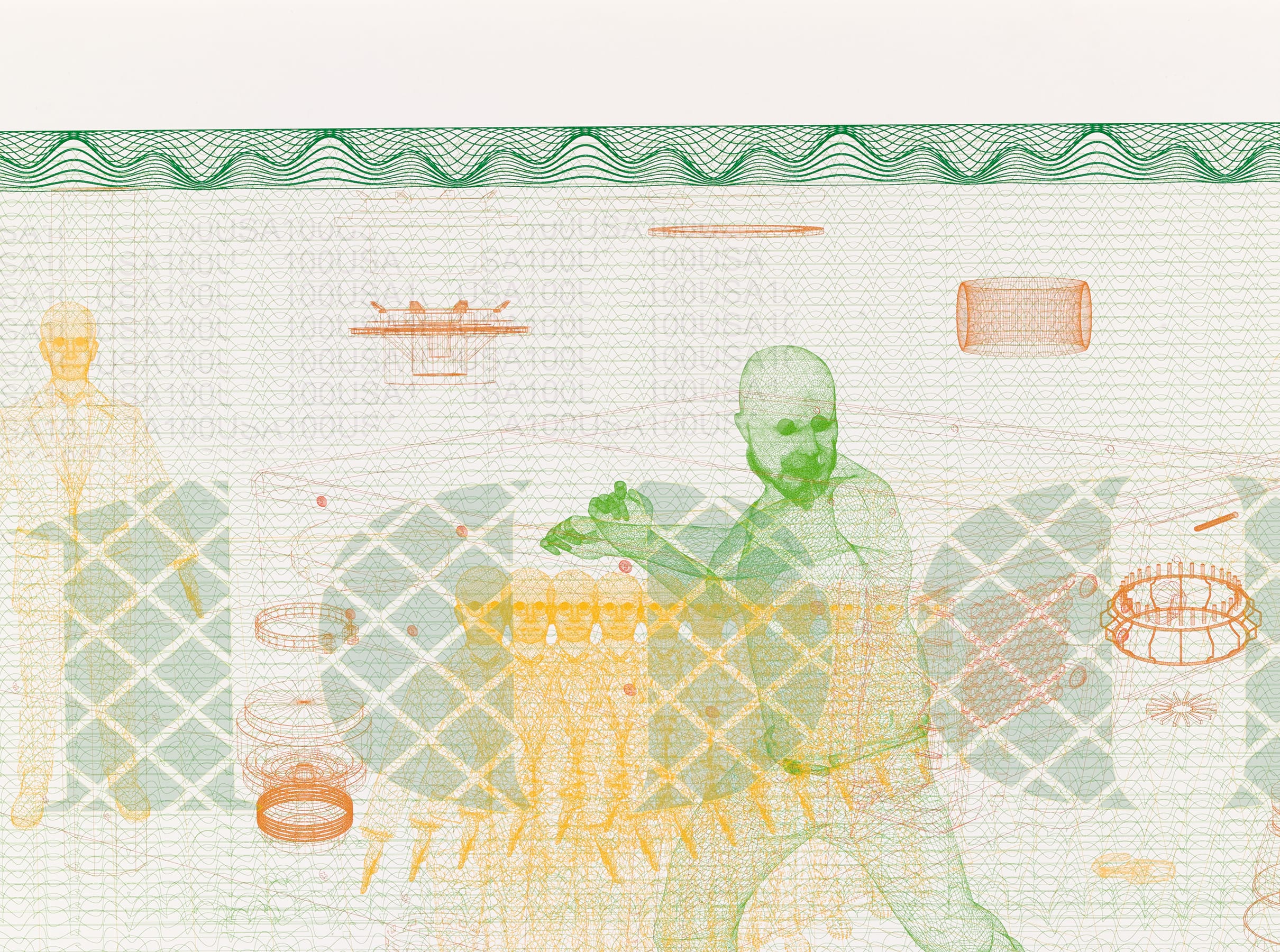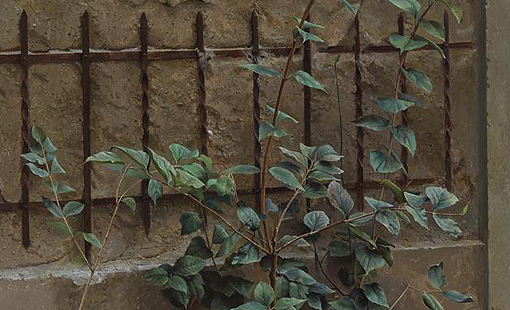
Banco de España Collection to loan six works to exhibitions this spring in Malaga, Pontevedra, Madrid and Cologne (Germany)
The Banco de España is involved in various initiatives to bring its historic and artistic heritage collection to the notice of the public. They include loaning works for exhibitions staged by other art organisations at home and abroad. In the spring of 20204 this loan policy will see works from the collection appearing in the exhibitions Isabel Quintanilla's Intimate Realism![]() at the Museo Nacional Thyssen-Bornemisza; Latent Modernity. Avant-garde and Innovative Painters in Spanish Figurative Art (1920-1970)
at the Museo Nacional Thyssen-Bornemisza; Latent Modernity. Avant-garde and Innovative Painters in Spanish Figurative Art (1920-1970)![]() at the Carmen Thyssen Museum in Malaga; Berta Cáccamo. Archive Correspondence
at the Carmen Thyssen Museum in Malaga; Berta Cáccamo. Archive Correspondence![]() , at the Pontevedra Museum; Art and Social Change in Spain (1885-1910)
, at the Pontevedra Museum; Art and Social Change in Spain (1885-1910)![]() , which is due to open on 21 May at the Museo Nacional del Prado; and A Revolution in Art: Paris 1863 - 1874. From Salon to impressionism, at the Wallraf-Richard-Museum & Fondation Corboud, based in Cologne, Germany.
, which is due to open on 21 May at the Museo Nacional del Prado; and A Revolution in Art: Paris 1863 - 1874. From Salon to impressionism, at the Wallraf-Richard-Museum & Fondation Corboud, based in Cologne, Germany.
![Pere Borrell del Caso: Huyendo de la crítica (Una cosa que no puede ser o Muchacho saliendo del cuadro) [1874]](/f/webca/ADS/Noticias/PrestAbr2024Txt01.jpg) Pere Borrell del Caso: Escaping Criticism (Something that Cannot Be or Boy Leaving the Picture) [1874]
Pere Borrell del Caso: Escaping Criticism (Something that Cannot Be or Boy Leaving the Picture) [1874]
This last exhibition, which looks at a key period in 19th century art in Europe, between the creation of the Salon des Refusés![]() (Salon of the Refused) and the first exhibition organised by the impressionists outside the scope of the Paris Salon, features one of the most iconic pieces in our collection: Escaping Criticism (1874), by Catalan painter Pere Borrell del Caso. The work has been used as the cover of several books that address widespread problems in pictorial art. It is bordered by a fake frame on which the figure of a boy is leaning, seemingly trying to escape from his own painting. This is the earliest known trompe d'oeil by a painter for whom the technique was to become a personal trademark. Borrell produced at least two more versions of this picture, each of them slightly different, and went on to produce other works depicting figures set within frames which they are leaning on or trying to escape from.
(Salon of the Refused) and the first exhibition organised by the impressionists outside the scope of the Paris Salon, features one of the most iconic pieces in our collection: Escaping Criticism (1874), by Catalan painter Pere Borrell del Caso. The work has been used as the cover of several books that address widespread problems in pictorial art. It is bordered by a fake frame on which the figure of a boy is leaning, seemingly trying to escape from his own painting. This is the earliest known trompe d'oeil by a painter for whom the technique was to become a personal trademark. Borrell produced at least two more versions of this picture, each of them slightly different, and went on to produce other works depicting figures set within frames which they are leaning on or trying to escape from.
Javier Portús explains that when Borrell del Caso painted this picture, this type of composition had been around for a long time in western art, where it was linked to the age-old aspiration of breaking away from two-dimensionality. However, he says, Escaping Criticism 'takes things a step further within the logic of trompe d'oeil', in that it shows not a static object or figure that seemingly belongs to our space, but rather an explicitly pictorial character struggling to break out of its 'prison' and into the real world. Oddly, the work has been known by different titles. In his personal accounts the artist himself referred to it as Boy Leaving the Painting and when it was first shown at the Objets d'Art Exhibition in Barcelona in 1874, where it proved very popular, it was entitled Something that Cannot Be. The reticence with which French critic Apel-Les Mestres regarded it may perhaps be the origin of the title by which it is known today. Portús explains that this title ties in with one of the 'fundamental clichés around which rhetoric on painting has been built up in the Modern and, especially, Contemporary ages, namely the weight attributed to critics and their status (as in the two-dimensional nature of the picture) as a restraining force against which artists have to struggle'.
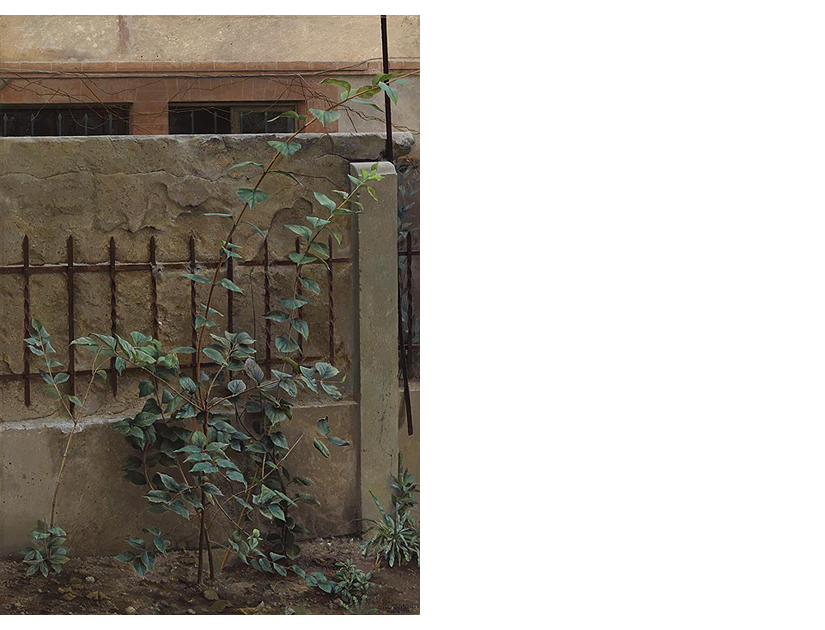 Isabel Quintanilla: Wall of the Urola Studio (1969)
Isabel Quintanilla: Wall of the Urola Studio (1969)
Another work from our collection currently out on loan is Wall of the Urola Studio (1969), an oil painting by Isabel Quintanilla that forms part of the monographic exhibition![]() of her work at the Museo Nacional Thyssen-Bornemisza
of her work at the Museo Nacional Thyssen-Bornemisza![]() . This painting, once owned by Italian writer Giovanni Testori, is a typical example of her intimate, poetic style, where centre stage is given to the observation of elements linked to everyday surroundings and to the treatment of (natural or artificial) light. Her subject here is the fence (and the plants growing at its base) around the studio that she shared with her husband, sculptor Francisco López, and with architect Rafael Moneo. With her characteristic diagonal viewpoint, and in a display of technical skill and in-depth knowledge of her matière, she captures the nuances of light in the space and time depicted without foregoing the analytical assessment of the emotions that always characterised her work.
. This painting, once owned by Italian writer Giovanni Testori, is a typical example of her intimate, poetic style, where centre stage is given to the observation of elements linked to everyday surroundings and to the treatment of (natural or artificial) light. Her subject here is the fence (and the plants growing at its base) around the studio that she shared with her husband, sculptor Francisco López, and with architect Rafael Moneo. With her characteristic diagonal viewpoint, and in a display of technical skill and in-depth knowledge of her matière, she captures the nuances of light in the space and time depicted without foregoing the analytical assessment of the emotions that always characterised her work.
Wall of the Urola Studio is not the only work by this artist in our collection. Quintanilla produced the large perimeter strips that have surrounded the canvases by Josep María Sert on the trading floor of the Banco de España’s branch in Barcelona since the 1980s (which have their own unique story, told here. In 1985 she also painted a portrait of governor José Ramón Álvarez-Rendueles, thus becoming the first female artist commissioned by the bank for such an official portrait.
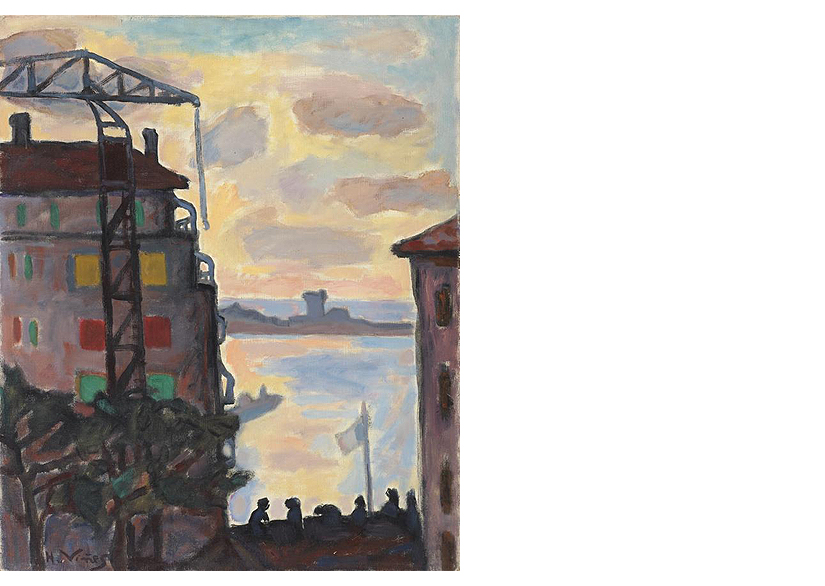 Hernando Viñes: Corner of a Harbour (1962)
Hernando Viñes: Corner of a Harbour (1962)
After Quintanilla, the second female artist to be charged by the bank with painting a portrait of a governor (indeed three governors) was Carmen Laffón, several of whose works are held in the collection. The oldest of these is Seville (1962), which is now on loan to the Carmen Thyssen Museum in Malaga![]() for the exhibition Latent Modernity. Avant-garde and Innovative Painters in Spanish Figurative Art (1920-1970)
for the exhibition Latent Modernity. Avant-garde and Innovative Painters in Spanish Figurative Art (1920-1970)![]() . Another work on loan to the same exhibition is Corner of a Harbour (1962) by French/Spanish artist Hernando Viñes. The exhibition takes a selection of over 70 works to examine the emergence at that time (and resilience against the complicated backdrop of the post-Civil War years) of figurative art tending towards modernity on the Spanish art scene. Viñes and Laffón were stand-out exponents of that scene.
. Another work on loan to the same exhibition is Corner of a Harbour (1962) by French/Spanish artist Hernando Viñes. The exhibition takes a selection of over 70 works to examine the emergence at that time (and resilience against the complicated backdrop of the post-Civil War years) of figurative art tending towards modernity on the Spanish art scene. Viñes and Laffón were stand-out exponents of that scene.
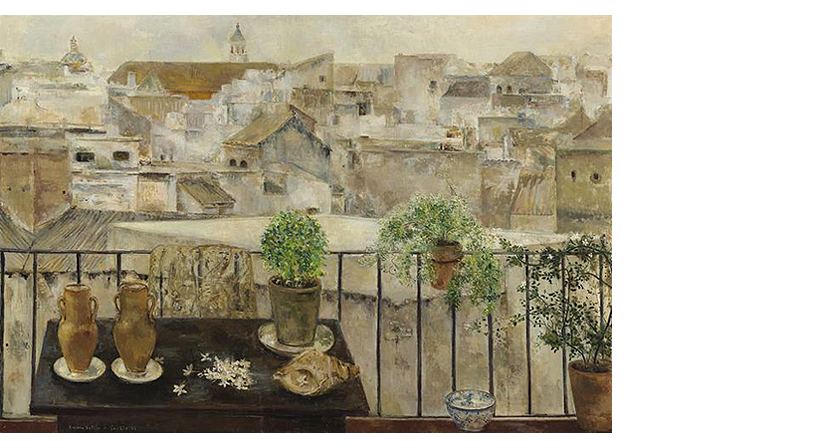 Carmen Laffón: Seville (1962)
Carmen Laffón: Seville (1962)
These two artists belong to very different generations, but the two works loaned out for this exhibition were both produced in 1962. Corner of a Harbour is a small oil painting in which Hernando Viñes (linked to the so-called Paris School, whose members also included Pancho Cossío, Francisco Bores and Joaquín Peinado) shows his skill in handling colours to create compositions which look simple but are imbued with a hypnotic, poetic strength. The painting is an interesting example of his personal visual style which, in the words of Roberto Díaz, 'blends together influences of Cubism and Fauvism, [...] often using windows as a compositional resource to produce a picture within a picture'. The other work loaned out is Seville by Laffón, a key figure in Spanish realism in the second half of the 20th century. This oil painting is from an early period in her career. It is unusual in that it is at once a landscape and a still life, thus representing two of the genres in which she specialised. Isabel Tejeda holds that it can be seen as 'typical and illustrative of her oeuvre', which has remained extraordinarily consistent in terms of expression and iconography throughout her career. The painting is marked by her ceaseless investigation into capturing light, and her constant predilection for humble, everyday motifs.
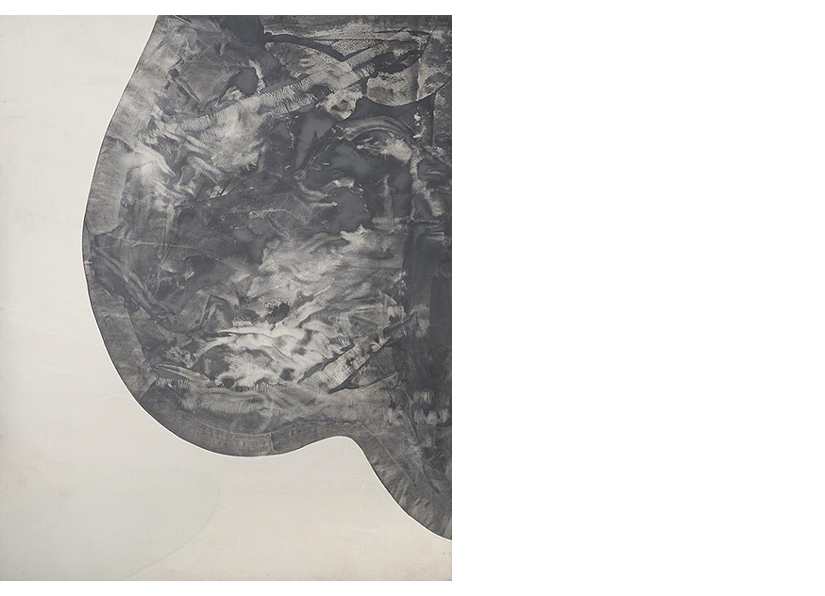 Berta Cáccamo: QNJ (1993)
Berta Cáccamo: QNJ (1993)
The most recent work from our collection currently out on loan is QNJ (1993), painted in acrylic on fabric by Galicia-born Berta Cáccamo, which the Banco de España acquired in 2020, just two years after the artist’s early death. It has been loaned out for Archive Correspondences![]() , an exhibition that opened on 12 April at the Pontevedra Museum
, an exhibition that opened on 12 April at the Pontevedra Museum![]() . This exhibition looks at the connections between the different registers to be found in her archives (notebooks, diaries, artist's sketch books, correspondence, photos and objects, among others) and her paintings and work on paper. This painting was produced during her time at the Spanish Academy in Rome in the early 1990s and reflects the shift towards more organic forms that marked her work at that time. In the words of Juan de Nieves, that shift 'gives rise to a sort of evanescent corporeality' that reflects her interest in both 'the observation of nature and the contingent nature of its elements' and 'the germinal, in what is about to happen'. This can also be seen in Untitled (Series) [1994], the other work by this artist in our collection. It comprises a number of monochrome images that highlight the increasing importance that Cáccamo was giving to the procedural and the gestural in her work.
. This exhibition looks at the connections between the different registers to be found in her archives (notebooks, diaries, artist's sketch books, correspondence, photos and objects, among others) and her paintings and work on paper. This painting was produced during her time at the Spanish Academy in Rome in the early 1990s and reflects the shift towards more organic forms that marked her work at that time. In the words of Juan de Nieves, that shift 'gives rise to a sort of evanescent corporeality' that reflects her interest in both 'the observation of nature and the contingent nature of its elements' and 'the germinal, in what is about to happen'. This can also be seen in Untitled (Series) [1994], the other work by this artist in our collection. It comprises a number of monochrome images that highlight the increasing importance that Cáccamo was giving to the procedural and the gestural in her work.
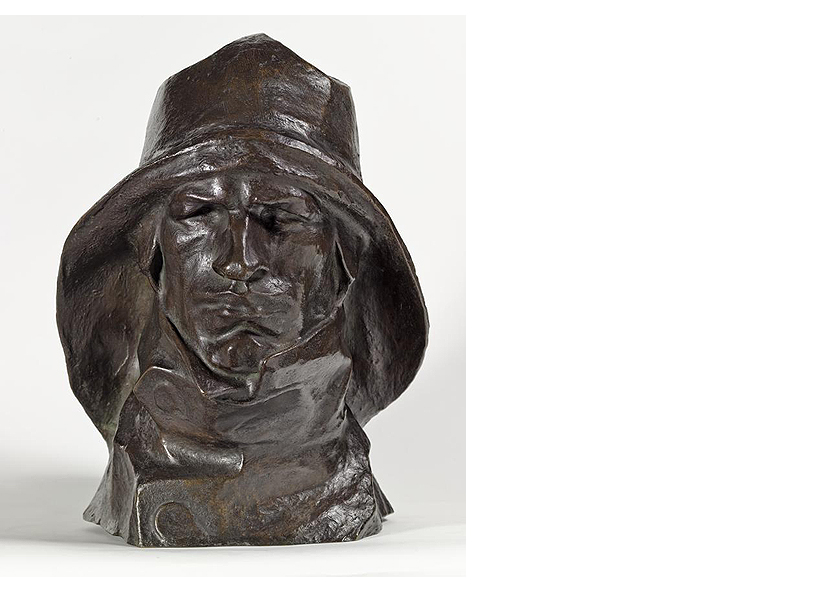
Mateo Inurria: Fisherman (1903)
There is one more work from our collection that is currently on loan, but to an exhibition that has not yet opened: Art and Social Change in Spain (1885-1910)![]() , scheduled to run from 21 May to 22 September 2024 at the Museo Nacional del Prado.
, scheduled to run from 21 May to 22 September 2024 at the Museo Nacional del Prado.![]() The work in question is Fisherman (1903), a patinated bronze bust in which Mateo Inurria replicates one of the two original stone allegories of the navy that he produced for the Monument to Alfonso XII
The work in question is Fisherman (1903), a patinated bronze bust in which Mateo Inurria replicates one of the two original stone allegories of the navy that he produced for the Monument to Alfonso XII![]() in Madrid's El Retiro Park. Inurria shows the figure with a large hat and a dry, serious gesture as if seeking to underscore its masculinity. This is in sharp contrast with the gentle, melancholic serenity of the female figure in Daydream (1922), the other work by the artist in our collection. Both these sculptures are interesting examples of that middle ground between the natural and the idealised, between aspiring modernity and academic correctness, in which the work of this Cordoba-born artist moves.
in Madrid's El Retiro Park. Inurria shows the figure with a large hat and a dry, serious gesture as if seeking to underscore its masculinity. This is in sharp contrast with the gentle, melancholic serenity of the female figure in Daydream (1922), the other work by the artist in our collection. Both these sculptures are interesting examples of that middle ground between the natural and the idealised, between aspiring modernity and academic correctness, in which the work of this Cordoba-born artist moves.
